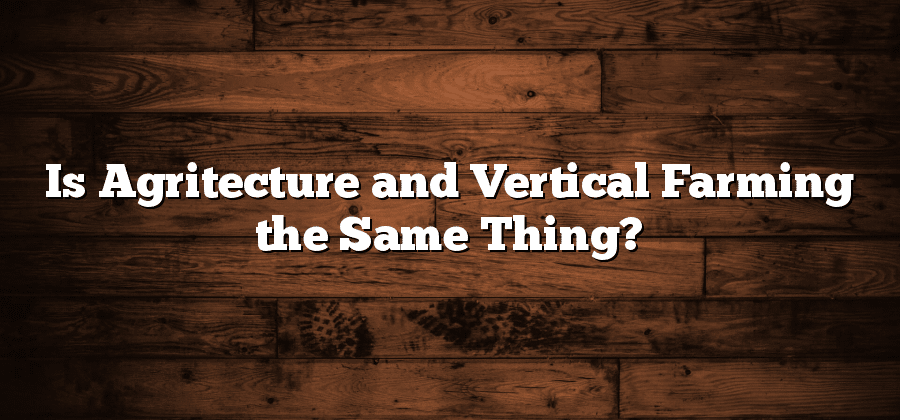Definition of Agritecture and Vertical Farming
Agritecture can be defined as the innovative integration of agricultural practices within the framework of urban architecture. It combines the art and science of designing and implementing sustainable and productive agricultural systems into urban landscapes, such as buildings, rooftops, and public spaces. The concept of agritecture aims to maximize the use of limited space in urban environments by utilizing vertical and horizontal structures to grow food, improve air quality, and enhance the overall well-being of urban communities.
On the other hand, vertical farming is a method of cultivating crops in vertically stacked layers or racks, typically within a controlled environment such as a greenhouse or an indoor facility. This approach revolutionizes traditional agricultural practices by minimizing land usage and utilizing advanced technologies like hydroponics, aeroponics, and artificial lighting systems. Vertical farming allows for year-round production of a wide range of crops, independent of external weather conditions, and provides optimal control over factors like temperature, humidity, and nutrient levels.
Agritecture: A New Approach to Urban Agriculture
Agritecture is a rapidly emerging field that aims to revolutionize urban agriculture by integrating architecture and agriculture. Unlike traditional farming methods that require vast open spaces, agritecture focuses on utilizing vertical space in urban environments to grow crops. This innovative approach to urban agriculture is gaining momentum as cities around the world grapple with issues of limited land availability and the need for sustainable food production.
One of the key advantages of agritecture is its ability to transform underutilized spaces such as rooftops, walls, and abandoned buildings into thriving green spaces that produce fresh fruits, vegetables, and herbs. By incorporating hydroponic and aeroponic systems, agritects are able to optimize resource usage and minimize environmental impact. Additionally, the controlled environment and automation technologies used in agritecture allow for year-round crop cultivation, ensuring a consistent supply of locally grown produce regardless of seasonal constraints. The integration of architecture and agriculture in agritecture not only addresses food security concerns but also presents opportunities for community engagement, social interaction, and economic development within urban areas.
Vertical Farming: Revolutionizing the Future of Agriculture
Vertical farming is rapidly gaining popularity as a revolutionary approach to agriculture, promising to redefine the future of food production. Unlike traditional farming methods that rely heavily on expansive land areas, vertical farming maximizes space by growing crops in stacked layers, often within controlled environments such as buildings or greenhouses.
This innovative technique offers numerous advantages over conventional agriculture. Firstly, vertical farming enables year-round production, unaffected by seasonality or adverse weather conditions. By harnessing advanced technology such as hydroponics or aeroponics, crops can be grown efficiently and sustainably, using minimal water and nutrients. Moreover, vertical farming reduces the need for pesticides and herbicides, promoting healthier and more environmentally friendly food options. With its potential to increase food security, reduce transportation costs, and minimize agricultural land requirements, vertical farming is truly revolutionizing the future of agriculture.
Key Similarities between Agritecture and Vertical Farming
Agriculture has always been influenced by the need to adapt to limited resources and an ever-increasing global population. In recent years, agritecture and vertical farming have emerged as solutions to these challenges, revolutionizing the way we perceive and practice agriculture. Despite their distinct methods and definitions, agritecture and vertical farming share key similarities that make them complementary approaches to sustainable urban agriculture.
Both agritecture and vertical farming aim to maximize crop production in limited urban spaces. By utilizing innovative techniques, such as hydroponics and aeroponics, both methods prioritize space optimization, allowing for vertical cultivation and the integration of green spaces into urban landscapes. This efficient use of real estate not only addresses the problem of limited land availability but also helps reduce transportation and distribution costs associated with traditional agriculture. Thus, both agritecture and vertical farming contribute to the overall goal of achieving self-sufficiency in food production within urban areas.
Differentiating Factors: Agritecture versus Vertical Farming
Agritecture and vertical farming are two distinct approaches to urban agriculture that have gained significant attention in recent years. While they share some similarities, there are key differentiating factors that set them apart.
Agritecture, as the name suggests, refers to the integration of agriculture and architecture. It emphasizes the use of innovative design principles and technologies to incorporate agricultural practices into urban spaces. This approach focuses on creating aesthetically appealing and efficiently functional structures that seamlessly blend agriculture with urban environments. It often involves repurposing existing buildings or designing new ones to accommodate various agricultural systems, such as hydroponics or aquaponics. Agritecture aims to maximize space utilization and create sustainable urban food production systems.
On the other hand, vertical farming is a specific technique within the broader concept of urban agriculture. It involves growing plants in vertically stacked layers or towers, often indoors or in controlled environments. Vertical farming utilizes advanced technologies, such as artificial lighting, climate control, and automated irrigation systems, to optimize plant growth and minimize resource consumption. By utilizing vertical space, this approach enables high crop yields in a relatively small footprint. Vertical farms can be standalone structures or integrated into existing buildings, allowing for year-round production of fresh produce regardless of external weather conditions.
While both agritecture and vertical farming share the objective of promoting urban agriculture, they differ in their primary focus and execution. Agritecture emphasizes the integration of agriculture and architecture to create functional and visually appealing urban agricultural systems, while vertical farming focuses specifically on the technique of growing plants in stacked layers within controlled environments. Understanding these differences is crucial to fully grasp the potential of these approaches and their respective contributions to the future of urban agriculture.






